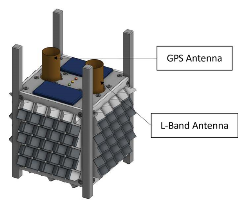| Name | Rock-Lopen |
|---|---|
| Spacecraft type | CubeSat |
| Units or mass | 1.5U |
| Organization | Array Labs |
| Institution | Company |
| Entity type | Commercial |
| Nation | US |
| Oneliner |
Determine the performance of a novel surface coating developed by Array Labs, one satellite (Lopen) has it and second one (Rock) does not. |
| Description |
The overall goal of the Rock & Lopen mission is to determine the performance of a novel surface coating developed by Array Labs. The coating is expected to increase the effect of attitude on the amount of drag a spacecraft in LEO experiences, enhancing the ability for LEO spacecraft to intentionally increase or decrease drag forces during a mission. This mission consists of two nearly identical 1.5U satellites. One spacecraft (“Lopen”) will have the novel coating applied to all its external surfaces, and another (“Rock”) will serve as a control for the experiment and will have no special surface coating applied. Based on each spacecraft’s position over time and their relative orbital decay rates, Array Labs will demonstrate the effect of the novel coating on drag in LEO. Performance data derived from this mission will be used to inform the design of Array Labs’ future earth imagery constellations. Each of the two spacecraft has identical overall physical dimensions of 10 cm X 10 cm X 17.7 cm). The total mass is about 1.83 kg |
| Sources | [1] [2] |
| Photo sources | [1] |
| COTS subsystems |
|
| Keywords | Globalstar or Iridium or Inmarsat |
Related Spacecraft
| Satellite | Status | Launcher | Launch | Orbit |
|---|---|---|---|---|
| Lopen (Array Labs) | Operational (Contact established as per post on X on 2024-08-19) | Falcon 9, (Transporter-11) | 2024-08-16 | 515 km, 97.5 deg |
| Rock (Array Labs) | Operational (Contact established as per post on X on 2024-08-19) | Falcon 9, (Transporter-11) | 2024-08-16 | 515 km, 97.5 deg |
Last modified: 2024-09-29

